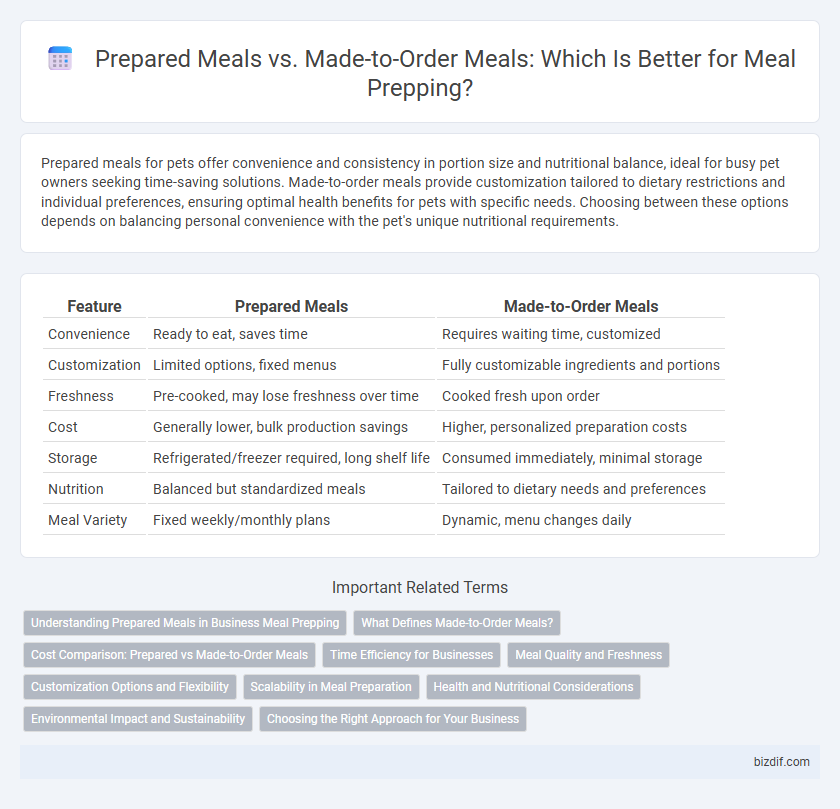Prepared meals for pets offer convenience and consistency in portion size and nutritional balance, ideal for busy pet owners seeking time-saving solutions. Made-to-order meals provide customization tailored to dietary restrictions and individual preferences, ensuring optimal health benefits for pets with specific needs. Choosing between these options depends on balancing personal convenience with the pet's unique nutritional requirements.
Table of Comparison
| Feature | Prepared Meals | Made-to-Order Meals |
|---|---|---|
| Convenience | Ready to eat, saves time | Requires waiting time, customized |
| Customization | Limited options, fixed menus | Fully customizable ingredients and portions |
| Freshness | Pre-cooked, may lose freshness over time | Cooked fresh upon order |
| Cost | Generally lower, bulk production savings | Higher, personalized preparation costs |
| Storage | Refrigerated/freezer required, long shelf life | Consumed immediately, minimal storage |
| Nutrition | Balanced but standardized meals | Tailored to dietary needs and preferences |
| Meal Variety | Fixed weekly/monthly plans | Dynamic, menu changes daily |
Understanding Prepared Meals in Business Meal Prepping
Prepared meals in business meal prepping offer convenience and consistency by being cooked, portioned, and packaged in advance for quick distribution. These meals reduce on-demand cooking time and streamline operations for corporate cafeterias or catering services, ensuring uniform quality and nutritional balance. Businesses benefit from cost efficiency and scalability, as bulk preparation lowers ingredient waste and labor expenses compared to made-to-order meals.
What Defines Made-to-Order Meals?
Made-to-order meals are freshly prepared after receiving a customer's request, ensuring customization according to individual preferences and dietary needs. These meals prioritize ingredient freshness and portion control, catering to specific taste, allergen restrictions, or nutritional goals. Unlike prepared meals, made-to-order options reduce food waste by aligning preparation directly with demand and personal requirements.
Cost Comparison: Prepared vs Made-to-Order Meals
Prepared meals generally offer significant cost savings compared to made-to-order meals due to bulk ingredient purchasing and reduced labor expenses, averaging 30-50% less per serving. Made-to-order meals often incur higher costs from customized ingredients, chef preparation time, and real-time cooking, which can increase prices by 1.5 to 2 times. Consumers looking to optimize food budgets will find prepared meals more economically efficient, especially when balancing convenience and portion control.
Time Efficiency for Businesses
Prepared meals save valuable time for businesses by streamlining kitchen operations and minimizing food preparation duration, allowing staff to focus on service and customer engagement. Made-to-order meals require longer preparation times, potentially causing delays and reducing table turnover rates. Efficient meal prepping with prepared meals supports higher volume service and consistent meal quality, optimizing overall operational workflow.
Meal Quality and Freshness
Prepared meals offer consistent quality by being cooked in controlled environments but may lack the freshness of made-to-order meals, which are cooked immediately to preserve optimal taste and texture. Made-to-order meals ensure higher nutrient retention and are tailored to individual preferences, enhancing meal satisfaction. However, prepared meals provide convenience and portion control, supporting efficient meal planning without sacrificing overall nutritional value.
Customization Options and Flexibility
Prepared meals offer limited customization options, typically providing fixed menus designed for convenience and quick consumption. Made-to-order meals deliver greater flexibility, allowing customers to tailor ingredients, portion sizes, and dietary preferences to meet specific nutritional needs. This adaptability in made-to-order meals caters to individual health goals, allergies, and taste preferences, enhancing personalized dining experiences.
Scalability in Meal Preparation
Prepared meals offer high scalability in meal preparation by allowing large batches to be cooked simultaneously and stored for future consumption, significantly reducing time and labor costs. Made-to-order meals require individualized preparation, limiting scalability due to longer preparation times and increased resource needs per order. Efficient use of batch cooking techniques and standardized recipes enhances scalability in prepared meals, making them ideal for meal preppers managing multiple servings.
Health and Nutritional Considerations
Prepared meals often contain higher levels of sodium, preservatives, and added sugars compared to made-to-order meals, which can impact overall health and nutritional balance. Made-to-order meals allow for greater control over ingredient quality, portion size, and macronutrient distribution, supporting personalized dietary needs and minimizing unhealthy additives. Choosing made-to-order options promotes fresher ingredients and better nutrient retention, essential for maintaining optimal energy and wellness.
Environmental Impact and Sustainability
Prepared meals often generate less food waste through precise portioning and bulk cooking efficiencies, reducing overall energy consumption in production compared to made-to-order meals. Made-to-order meals can lead to higher environmental impact due to frequent cooking cycles, increased packaging needs, and less optimized ingredient usage. Sustainable meal prepping favors prepared meals that utilize seasonal ingredients and minimize single-use plastics, thereby lowering carbon footprints and resource depletion.
Choosing the Right Approach for Your Business
Prepared meals offer consistency, scalability, and efficient inventory management, making them ideal for businesses targeting high-volume sales and standard menu options. Made-to-order meals provide customization and freshness, appealing to customers seeking personalized dining experiences and flexibility in ingredient choices. Selecting the right approach depends on your business model, kitchen capacity, and customer preferences to maximize satisfaction and operational efficiency.
Prepared meals vs made-to-order meals Infographic

 bizdif.com
bizdif.com